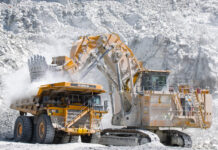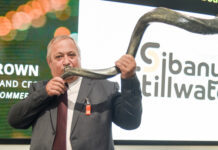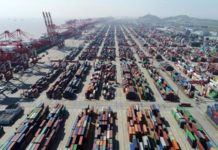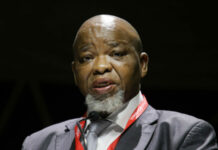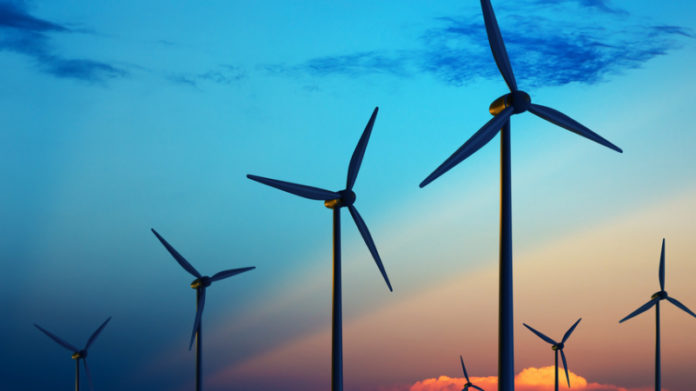
UNLESS there’s a doubling in capital expenditure by the world’s mining companies, the world has virtually no chance of limiting global warming to 1.5oC as targeted in the Paris Agreement. That’s the key finding in a June report by Bank of America (BoA), which says mining sector spending on the development of metals production should be $160bn a year instead of the $99.5bn historic average (see graph).
“Based on the current resource endowment and market balances, we don’t expect the 1.5oC global warming target to be achieved by 2050: 1.7 to 1.8oC looks likely. One solution to resolving shortages and constraints, as ever, lies in investment,” BoA says.
What’s required is not the discovery of one or two key ingredients, but a host of metals drawn from every corner of the periodic table. BoA describes them as “metals important for future technologies” – substances critical to making batteries for electric vehicles (EVs) and motors to drive solar and wind power generation.
The search by the world’s largest mining companies is already on for copper and cobalt. Lithium and nickel are also widely recognised as being in demand. But there are less-recognised minerals that play an equally important role in decarbonising technology, such as manganese, or the more obscure ones such as gallium that, worryingly for the West, is controlled by China.
In addition to resource scarcity, China’s dominance in the EV supply chain is a concern, especially to the US. In the case of lithium, used in the lithium-ion battery, China controls more than half of its processing and refining capacity. China also has three-fourths of the lithium-ion battery mega-factories in the world, according to the International Energy Agency. Given that auto manufacturers have set down ambitious growth targets for EVs – the world’s largest car manufacturer, Toyota, says it aims to sell 3.5 million EVs a year by 2030 – the West is at risk of falling short. It is currently far behind in the processing stakes: only 1% of global lithium is mined and processed within its borders, says the US Geological Survey. As for raw production of the mineral, about 80% is mined in Australia, Chile and China.
This article first appeared in The Mining Yearbook 2022 which can be accessed free of charge here >>
“Geographic concentrations create supply and logistics risks,” says market research company Fast Markets. While it expects these risks to lessen from 2025, Fast Markets says they will “continue to have an outsized impact on the market” owing to the continued prevalence of Covid variants, conflicts and resource nationalism.
Based on the current resource endowment and market balances, we don’t expect the 1.5oC global warming target to be achieved by 2050: 1.7 to 1.8oC looks likely.
So there’s massive pressure on mining companies to step up to the plate. The trouble is they have internal conflicts of their own. Investors are reticent about allowing unchecked spending on the type of growth that wrecked the sector for four years between 2012 and 2016. And as pointed out in this publication, permitting of new projects is a major headache: it’s time-consuming and expensive, and increasingly results in disappointment.
Quantum leap
Another way of looking at the metals supply crisis is just what the mining industry needs to produce in order to meet climate change goals. In order to hit the trajectory required for 2050 net-zero emissions, copper production needs to be 9.98 million tons a year by 2030, a compound average growth rate of 14%, says BoA. In nickel, however, the compound annual growth rate (CAGR) in required production is 40% (growth from the 94,983t produced in 2020 to 2.84Mt by 2030). It’s a similar picture for lithium (CAGR +38%), platinum (+78%) and cobalt (+28%).
The scarcity of new metals production has also resulted in price inflation. In 2021, lithium gained 280%, making the manufacture of batteries and motors increasingly expensive.
Rising primary material costs will inevitably be passed on to automotive manufacturers such as Tesla, and quite possibly to consumers, potentially hurting EV demand.
Quite often in such scenarios, the scientists are sent back to the lab to find less expensive technology. In summary, bold assumptions about metals supply in today’s battery may be unseated in the future, making long-term planning for mining companies tricky, volatile, and financially hazardous.
For Neal Froneman, CEO of Sibanye-Stillwater, the likelihood is industry will become catholic in its choices, particularly in respect of mobility. “Battery EVs have their role, and especially in Europe and in cities, and internal combustion engines and fuel cells [using hydrogen technology] have their roles,” he says. “We are in the fortunate position where we don’t have to promote one [metal] at the expense of the other as they all have space in the mobility sector.”
Young Turks
To be clear, though, mining companies are hardly beleaguered, especially those with specialist intellectual capital, or junior miners that had the foresight to recognise where the market was heading. According to PwC in its annual ‘Mine’ report, published in June, the market capitalisations of the top five lithium, graphite and rare earth producers grew 56%, 101% and 154% respectively last year. By comparison, the market capitalisation of the world’s top 40 companies grew only 7%.
Robin Birchall, CEO of Toronto-listed Giyani Metals, is bullish on his firm’s ability to participate in the new wave of resource discovery and development that BoA believes is necessary. “We’ve certainly seen much better capital markets and availability of capital,” he said in an interview. He estimates there are 27 different potential providers of capital for his company including private equity, or firms that frontload capital in return for metals offtake, others that take a royalty stream, or those that provide straight-up equity as well as ‘vanilla’ debt providers. “There’s a lot of interest right now,” he says.
Giyani Metals is in Botswana, where its principal project is K-Hill. Established on a previously mined orebody, Birchall wants it to produce manganese. It’s not a ‘rare’ metal, with 20Mt/year in global supply, mostly to the steel industry where it’s used as a hardening agent. But 0.5% of production is now supplied to lithium-ion battery producers. What’s interesting about Giyani is it’s producing a special grade of manganese known as high-purity electrolytic manganese metal.
According to PwC, this type of product focus is typical of the ‘new’ miners, encouraged into production to supply ‘precursor materials’. “Precursor materials are the more refined inputs into energy transition technologies, such as lithium hydroxide rather than spodumene concentrate, or cobalt sulphate rather than cobalt concentrate,” says PwC in ‘Mine’. In the last three years, $5bn has been invested in lithium hydroxide projects in Western Australia alone.
It’s no surprise Australia has become the epicentre of new investment in lithium as the country – along with Chile, Argentina and China – has the most global resources. Zimbabwe has emerged as a new source of lithium while other new entrants abound in places like the former Commonwealth of Independent States countries, made up of post-Soviet nations. According to McKinsey & Company, the proliferation of resource options means there are enough new lithium reserves to meet battery growth, which will account for 90% of all lithium produced in five years’ time.
“Despite expectations that lithium demand will rise from approximately 500,000 tons of lithium carbonate equivalent in 2021 to some three million tons in 2030, we believe that the lithium industry will be able to provide enough product to supply the burgeoning lithium-ion battery industry,” McKinsey says. Conventional lithium supply is forecast to increase 300% between 2021 and 2030 through the development of new processing technologies, such as direct lithium extraction and direct lithium to product. These technologies “can be driving forces behind the industry’s ability to respond more swiftly to soaring demand”, it says.
I feel that for the green electric vehicle, and this green economy they [OEMs] are going to want provenance because we know the Chinese rare earth elements are very damaging.
Africa has competitive advantages in this regard, according to Vanessa Ushie, a director at the African Development Bank. Research commissioned by the bank found it is three times cheaper to establish a battery precursor plant in the Democratic Republic of Congo than it is in the US, China or Europe. What’s needed, however, is for policy reforms and unprecedented regional cooperation that creates the right investment conditions. Ushie suggests that Africa become a free trade area. “We want to position Africa to penetrate the EV minerals and battery value chain,” Ushie said in a presentation to the Mining Indaba conference in Cape Town this year. “There is tremendous opportunity, a historical opportunity.”
Paying for provenance
Demetrios Papathanasiou, global director of energy and extractives at the World Bank, believes Africa is ideally positioned in terms of green energy supply. As the continent has not developed the infrastructure linked to fossil fuels, it’s a natural place to develop greener battery metals production.
“The important point is that Africa vis-a-vis other places in the world has not yet developed the infrastructure which is massively linked to fossil fuel. The opportunity that Africa has is to move directly into cleaner and more efficient ways of using energy. Batteries are a key part of that,” he said at the Africa Indaba. “Africa has wonderful renewable resources and has some of the best solar in the world.”
For many original equipment manufacturers (OEMs) of battery metals, provenance is an increasingly important value. Social conscience is a key consumption driver, but a supply chain that can’t sufficiently prove its green credentials is an uncompetitive one. This is where Africa and the rest of the world have a potential advantage, says George Bennett.
We want to position Africa to penetrate the EV minerals and battery value chain. There is tremendous opportunity, a historical opportunity.
Bennett is CEO of Rainbow Rare Earths, a London-listed firm that is building a brownfields mine in Phalaborwa in South Africa’s Limpopo province. Rare earths – specifically neodymium and praseodymium – supply the wind-powered energy industry and are are critical to the manufacture of long-life magnets that drive the wind turbines. Says Bennett: “I feel that for the green electric vehicle, and this green economy they [OEMs] are going to want provenance because we know the Chinese rare earth elements are very damaging. They’ve destroyed the environment”.
A consequence of this is that once in production, Rainbow Rare Earth’s precursor minerals will fetch a premium. That helps the business case, especially when it comes to arranging the finance. Bennett says the lead time for developing Phalaborwa, and most likely the company’s second project in Burundi, has shortened relative to historic financing and development of mining projects.
“From cradle to grave is anywhere between 12 and 20 years,” says Bennett of a mine’s normal life cycle. “I am going to be looking to financing and starting construction in 2024. I only secured the project in January 2021, so it’s incredibly fast-tracked to bring new supply of neodymium and praseodymium supply on to the market. It’s extremely fast track.”
As with Giyani’s Birchall, Bennett doesn’t think finance will be a problem. Birchall is equally relaxed about some of the other pressures raised by the industry such as the prospect that inflation, resource scarcity and geopolitical stressors will unseat OEM production plans. The EV drive is here to stay, he says.
“You might have in aggregate fewer vehicles [as a result of shortages], but manufacturers are not going back,” Birchall says. “When an investment is made by a large industrial concern, like a car company, it’s a minimum of a 10-year cycle.” The commercial disaster of becoming a niche supplier of ICEs in a world of growing EV popularity is a fear pushing all automakers to at least the partial adoption of battery technology.
This article first appeared in The Mining Yearbook 2022 which can be accessed free of charge here >>




